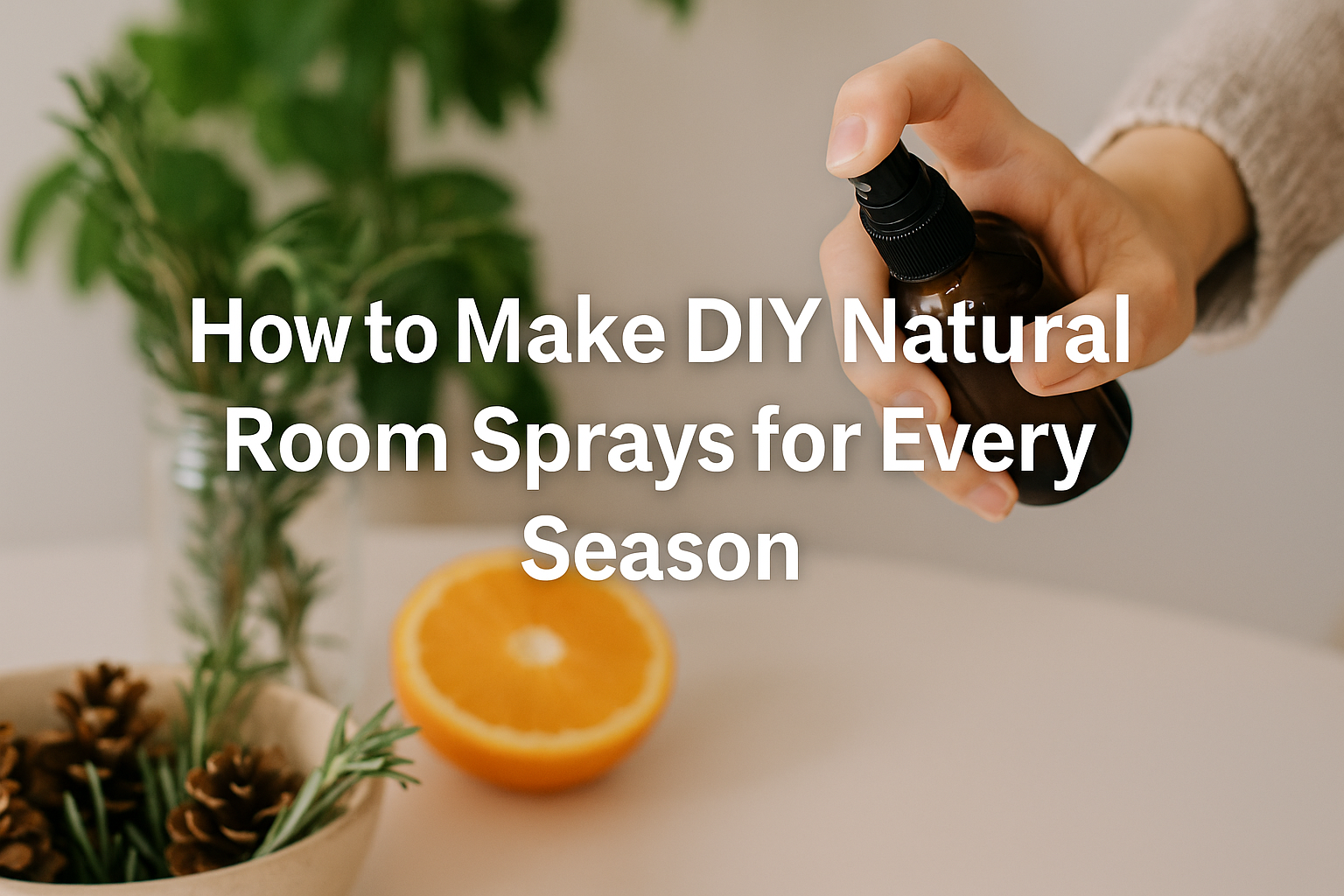Room sprays are one of the fastest ways to change the energy of a space. With a few spritzes, you can refresh stale air, set a relaxing mood, or bring seasonal joy into your home.
Commercial sprays often rely on artificial fragrances and aerosols, which mask odors temporarily but can trigger allergies or pollute indoor air. A healthier, more sustainable solution is to make your own DIY natural room sprays.
These sprays are easy to prepare, inexpensive, and customizable. With herbs, citrus, and essential oils, you can design blends that match every season of the year.
In spring, light and floral scents bring renewal. In summer, citrus and mint refresh hot days. In autumn, warm spices and herbs create comfort. In winter, grounding blends of marcela, sage, and citrus add calm and protection.
This guide explores why room sprays work, how to prepare them step by step, and offers seasonal recipes to keep your home fresh and meaningful throughout the year.
Why natural room sprays work
Herbs and citrus contain volatile compounds that evaporate quickly, releasing aroma into the air. Essential oils not only provide fragrance but also antibacterial and antifungal properties.
Unlike synthetic perfumes, natural blends create subtle freshness without overwhelming. They are also safe for children and pets when used correctly.
Benefits of DIY room sprays
They are customizable for mood and season. They avoid harmful chemicals and VOCs. They are eco-friendly, since bottles can be reused.
They are affordable, often costing a fraction of commercial sprays. They reconnect modern routines with traditional practices of using herbs to cleanse and refresh homes.
Basic formula for natural sprays
- 200 ml distilled water
- 1 tsp alcohol or witch hazel (helps blend oils)
- 15–20 drops essential oils (single or blended)
Combine in a dark spray bottle, shake before use, and spray lightly into the air or onto fabrics.
Tools you need
- Glass spray bottles
- Small funnel
- Measuring spoons
- Labels for each blend
Spring room sprays
Floral Renewal Spray
- 8 drops lavender
- 6 drops orange
- 4 drops rosemary
Fresh, uplifting, and balanced for mornings.
Herbal Garden Spray
- 6 drops marcela
- 6 drops chamomile
- 6 drops lemon
Calming and refreshing, ideal for bedrooms.
Blooming Citrus Spray
- 8 drops grapefruit
- 6 drops lemon
- 4 drops mint
Brightens mood and energizes.
Summer room sprays
Cooling Mint Spray
- 10 drops peppermint
- 6 drops lime
- 4 drops rosemary
Refreshing after hot afternoons.
Tropical Citrus Spray
- 8 drops orange
- 6 drops lemon
- 6 drops coconut extract (optional)
Cheerful and energizing.
Boldinho Fresh Kitchen Spray
- 6 drops boldinho
- 6 drops lime
- 4 drops rosemary
Neutralizes odors after meals.
Autumn room sprays
Warm Spice Spray
- 8 drops cinnamon
- 6 drops orange
- 4 drops clove
Creates cozy atmosphere on cool days.
Rosemary Comfort Spray
- 8 drops rosemary
- 6 drops marcela
- 4 drops guaco
Grounding and soothing after long days.
Citrus Wood Spray
- 8 drops lemon
- 6 drops cedarwood
- 4 drops sage
Balances freshness with depth.
Winter room sprays
Sage Protection Spray
- 10 drops sage
- 6 drops marcela
- 4 drops rosemary
Cleanses and resets heavy energy.
Winter Comfort Spray
- 8 drops cinnamon
- 6 drops orange
- 4 drops lavender
Adds warmth and calm to evenings.
Marcela Rest Spray
- 8 drops marcela
- 6 drops chamomile
- 6 drops orange
Supports relaxation before bedtime.
How to use sprays in routines
Morning refresh
Spray citrus blends in living rooms to start the day with clarity.
Afternoon reset
Use mint and rosemary sprays to counter fatigue.
Evening calm
Spray marcela or lavender blends on curtains and linens.
Weekly ritual
Use sage spray at thresholds on Sundays to symbolically cleanse and reset.
Seasonal transition
Switch blends every 3 months to align home atmosphere with nature’s cycles.
Cultural roots of room sprays
In Gaúcho homes, herbs like rosemary and marcela were boiled to cleanse rooms or used in bundles for protection. Citrus peels were simmered after meals to refresh kitchens. Today’s DIY sprays continue this tradition with modern tools, turning old practices into accessible rituals.
Safety tips
Shake sprays before each use. Test on fabrics to avoid staining. Avoid spraying directly on pets or infants. Store in cool, dark places. Use subtlety—two or three sprays are enough for most rooms.
Mistakes to avoid
Do not overload oils; too much fragrance can be overpowering. Do not store in plastic bottles long-term. Do not expect natural sprays to smell like synthetic perfumes; their freshness is subtler but healthier.
Frequently Asked Questions
How long do DIY sprays last?
About 2–3 weeks when stored in dark bottles. Refresh monthly for best results.
Can I use tap water instead of distilled?
Yes, but distilled water prevents bacteria growth and extends shelf life.
Do essential oils stain fabrics?
Most do not when diluted, but always test on small areas first.
Can children and pets be around sprays?
Yes, but avoid direct contact. Use gentle oils like lavender, chamomile, and orange for safe blends.
Why use alcohol or witch hazel?
They help oils mix with water and make the spray last longer in the air.
Conclusion
DIY natural room sprays are simple, safe, and customizable. They refresh air, align homes with seasons, and carry cultural meaning from traditional herb use.
With citrus, herbs, and essential oils, you can design sprays for spring renewal, summer energy, autumn comfort, and winter calm.
Every bottle becomes more than fragrance—it becomes a seasonal ritual of health and identity.

Marcela Cardozo is passionate about Southern Brazilian traditions and the cultural stories carried through natural scents. She blends knowledge of native herbs, essential oils, and regional rituals to create practical and inspiring content. Her writing connects ancestral wisdom with modern living, offering readers simple ways to bring authenticity, well-being, and meaning into their everyday lives.
